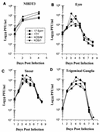The latent herpes simplex virus type 1 genome copy number in individual neurons is virus strain specific and correlates with reactivation
- PMID: 9620987
- PMCID: PMC110155
- DOI: 10.1128/JVI.72.7.5343-5350.1998
The latent herpes simplex virus type 1 genome copy number in individual neurons is virus strain specific and correlates with reactivation
Abstract
The viral genetic elements that determine the in vivo reactivation efficiencies of fully replication competent wild-type herpes simplex virus (HSV) strains have not been identified. Among the common laboratory strains, KOS reactivates in vivo at a lower efficiency than either strain 17syn+ or strain McKrae. An important first step in understanding the molecular basis for this observation is to distinguish between viral genetic factors that regulate the establishment of latency from those that directly regulate reactivation. Reported here are experiments performed to determine whether the reduced reactivation of KOS was associated with a reduced ability to establish or maintain latent infections. For comparative purposes, latent infections were quantified by (i) quantitative PCR on DNA extracted from whole ganglia, (ii) the number of latency-associated transcript (LAT) promoter-positive neurons, using KOS and 17syn+ LAT promoter-beta-galactosidase reporter mutants, and (iii) contextual analysis of DNA. Mice latently infected with 17syn+-based strains contained more HSV type 1 (HSV-1) DNA in their ganglia than those infected with KOS strains, but this difference was not statistically significant. The number of latently infected neurons also did not differ significantly between ganglia latently infected with either the low- or high-reactivator strains. In addition to the number of latent sites, the number of viral genome copies within the individual latently infected neurons has recently been demonstrated to be variable. Interestingly, neurons latently infected with KOS contained significantly fewer viral genome copies than those infected with either 17syn+ or McKrae. Thus, the HSV-1 genome copy number profile is viral strain specific and positively correlates with the ability to reactivate in vivo. This is the first demonstration that the number of HSV genome copies within individual latently infected neurons is regulated by viral genetic factors. These findings suggest that the latent genome copy number may be an important parameter for subsequent induced reactivation in vivo.
Figures






Similar articles
-
A comparison of herpes simplex virus type 1 and varicella-zoster virus latency and reactivation.J Gen Virol. 2015 Jul;96(Pt 7):1581-602. doi: 10.1099/vir.0.000128. Epub 2015 Mar 20. J Gen Virol. 2015. PMID: 25794504 Free PMC article. Review.
-
Herpes Simplex Virus 1 Strains 17syn+ and KOS(M) Differ Greatly in Their Ability To Reactivate from Human Neurons In Vitro.J Virol. 2020 Jul 16;94(15):e00796-20. doi: 10.1128/JVI.00796-20. Print 2020 Jul 16. J Virol. 2020. PMID: 32461310 Free PMC article.
-
HSV-1 LAT Promoter Deletion Viruses Exhibit Strain-Specific and LAT-Dependent Epigenetic Regulation of Latent Viral Genomes in Human Neurons.J Virol. 2023 Feb 28;97(2):e0193522. doi: 10.1128/jvi.01935-22. Epub 2023 Feb 1. J Virol. 2023. PMID: 36722973 Free PMC article.
-
Replication of herpes simplex virus type 1 within trigeminal ganglia is required for high frequency but not high viral genome copy number latency.J Virol. 2000 Jan;74(2):965-74. doi: 10.1128/jvi.74.2.965-974.2000. J Virol. 2000. PMID: 10623759 Free PMC article.
-
Molecular basis of HSV latency and reactivation.In: Arvin A, Campadelli-Fiume G, Mocarski E, Moore PS, Roizman B, Whitley R, Yamanishi K, editors. Human Herpesviruses: Biology, Therapy, and Immunoprophylaxis. Cambridge: Cambridge University Press; 2007. Chapter 33. In: Arvin A, Campadelli-Fiume G, Mocarski E, Moore PS, Roizman B, Whitley R, Yamanishi K, editors. Human Herpesviruses: Biology, Therapy, and Immunoprophylaxis. Cambridge: Cambridge University Press; 2007. Chapter 33. PMID: 21348106 Free Books & Documents. Review.
Cited by
-
The HSV-1 Latency-Associated Transcript Functions to Repress Latent Phase Lytic Gene Expression and Suppress Virus Reactivation from Latently Infected Neurons.PLoS Pathog. 2016 Apr 7;12(4):e1005539. doi: 10.1371/journal.ppat.1005539. eCollection 2016 Apr. PLoS Pathog. 2016. PMID: 27055281 Free PMC article.
-
Cell Intrinsic Determinants of Alpha Herpesvirus Latency and Pathogenesis in the Nervous System.Viruses. 2023 Nov 22;15(12):2284. doi: 10.3390/v15122284. Viruses. 2023. PMID: 38140525 Free PMC article. Review.
-
A comparison of herpes simplex virus type 1 and varicella-zoster virus latency and reactivation.J Gen Virol. 2015 Jul;96(Pt 7):1581-602. doi: 10.1099/vir.0.000128. Epub 2015 Mar 20. J Gen Virol. 2015. PMID: 25794504 Free PMC article. Review.
-
Quantitation of latent varicella-zoster virus and herpes simplex virus genomes in human trigeminal ganglia.J Virol. 1999 Dec;73(12):10514-8. doi: 10.1128/JVI.73.12.10514-10518.1999. J Virol. 1999. PMID: 10559370 Free PMC article.
-
Efficacies of gel formulations containing foscarnet, alone or combined with sodium lauryl sulfate, against establishment and reactivation of latent herpes simplex virus type 1.Antimicrob Agents Chemother. 2001 Apr;45(4):1030-6. doi: 10.1128/AAC.45.4.1030-1036.2001. Antimicrob Agents Chemother. 2001. PMID: 11257012 Free PMC article.
References
-
- Davies A, Lumsden A. Relation of target encounter and neuronal death to nerve growth factor responsiveness in the developing mouse trigeminal ganglion. J Comp Neurol. 1984;223:124–137. - PubMed
-
- Glorioso J C, DeLuca N A, Fink D J. Development and application of herpes simplex virus vectors for human gene therapy. Annu Rev Microbiol. 1995;49:675–710. - PubMed
Publication types
MeSH terms
Substances
Grants and funding
LinkOut - more resources
Full Text Sources
Other Literature Sources
Research Materials

